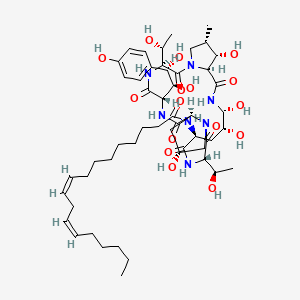Drug Information
Drug (ID: DG00629) and It's Reported Resistant Information
| Name |
Echinocandins
|
||||
|---|---|---|---|---|---|
| Synonyms |
Echinocandin B; 54651-05-7; UNII-CNW0ZW8ZTQ; CNW0ZW8ZTQ; Antibiotic SL 7810F; Antibiotic A 30912A; (9Z,12Z)-N-((2R,6S,9S,11R,12R,14aS,15S,16S,20S,23S,25aS)-23-((1S,2S)-1,2-dihydroxy-2-(4-hydroxyphenyl)ethyl)-2,11,12,15-tetrahydroxy-6,20-bis((R)-1-hydroxyethyl)-16-methyl-5,8,14,19,22,25-hexaoxotetracosahydro-1H-dipyrrolo[2,1-c:2',1'-l][1,4,7,10,13,16]hexaazacyclohenicosin-9-yl)octadeca-9,12-dienamide; (9Z,12Z)-N-{(2R,6S,9S,11R,12R,14aS,15S,16S,20S,23S,25aS)-23-[(1S,2S)-1,2-dihydroxy-2-(4-hydroxyphenyl)ethyl]-2,11,12,15-tetrahydroxy-6,20-bis[(1R)-1-hydroxyethyl]-16-methyl-5,8,14,19,22,25-hexaoxotetracosahydro-1H-dipyrrolo[2,1-c:2',1'-l][1,4,7,10,13,16]hexaazacyclohenicosin-9-yl}octadeca-9,12-dienamide; 5.1:6-anhydro{(4R,5R)-4,5-dihydroxy-N(2)-[(9Z,12Z)-octadeca-9,12-dienoyl]-L-ornithyl-L-threonyl-(4R)-4-hydroxy-L-prolyl-(4S)-4-hydroxy-4-(4-hydroxyphenyl)-L-threonyl-L-threonyl-(3S,4S)-3-hydroxy-4-methyl-L-proline}; Antibiotic A 22082; NSC 287461; A 30912A; Echinocandin B (9CI); A-22082; SCHEMBL17951640; CHEBI:315018; (9Z,12Z)-N-[(3S,6S,9S,11R,15S,18S,20R,21R,24S,25S,26S)-6-[(1S,2S)-1,2-dihydroxy-2-(4-hydroxyphenyl)ethyl]-11,20,21,25-tetrahydroxy-3,15-bis[(1R)-1-hydroxyethyl]-26-methyl-2,5,8,14,17,23-hexaoxo-1,4,7,13,16,22-hexazatricyclo[22.3.0.09,13]heptacosan-18-yl]octadeca-9,12-dienamide
Click to Show/Hide
|
||||
| Structure |

|
||||
| Drug Resistance Disease(s) |
Disease(s) with Resistance Information Validated by in-vivo Model for This Drug
(1 diseases)
[1]
|
||||
| Target | . | NOUNIPROTAC | [1] | ||
| Click to Show/Hide the Molecular Information and External Link(s) of This Drug | |||||
| Formula |
C52H81N7O16
|
||||
| IsoSMILES |
CCCCC/C=C\\C/C=C\\CCCCCCCC(=O)N[C@H]1C[C@H]([C@H](NC(=O)[C@@H]2[C@H]([C@H](CN2C(=O)[C@@H](NC(=O)[C@@H](NC(=O)[C@@H]3C[C@H](CN3C(=O)[C@@H](NC1=O)[C@@H](C)O)O)[C@@H]([C@H](C4=CC=C(C=C4)O)O)O)[C@@H](C)O)C)O)O)O
|
||||
| InChI |
1S/C52H81N7O16/c1-5-6-7-8-9-10-11-12-13-14-15-16-17-18-19-20-38(65)53-35-26-37(64)48(71)57-50(73)42-43(66)29(2)27-59(42)52(75)40(31(4)61)55-49(72)41(45(68)44(67)32-21-23-33(62)24-22-32)56-47(70)36-25-34(63)28-58(36)51(74)39(30(3)60)54-46(35)69/h9-10,12-13,21-24,29-31,34-37,39-45,48,60-64,66-68,71H,5-8,11,14-20,25-28H2,1-4H3,(H,53,65)(H,54,69)(H,55,72)(H,56,70)(H,57,73)/b10-9-,13-12-/t29-,30+,31+,34+,35-,36-,37+,39-,40-,41-,42-,43-,44-,45-,48+/m0/s1
|
||||
| InChIKey |
FAUOJMHVEYMQQG-HVYQDZECSA-N
|
||||
| PubChem CID | |||||
Type(s) of Resistant Mechanism of This Drug
Drug Resistance Data Categorized by Their Corresponding Diseases
ICD-01: Infectious/parasitic diseases
| Drug Resistance Data Categorized by Their Corresponding Mechanisms | ||||
|
|
||||
| Key Molecule: D-glucan-1,3-beta--UDP glucosyltransferase (FKS1) | [1] | |||
| Molecule Alteration | Mutation | p.S645P+p.S645Y+p.S645F |
||
| Resistant Disease | Recurrent oropharyngeal candidiasis [ICD-11: 1F23.6] | |||
| Experimental Note | Discovered Using In-vivo Testing Model | |||
| In Vitro Model | Candida albicans strain | 5476 | ||
| Mechanism Description | For most Candida species, echinocandin resistance is primarily mediated by mutations in the FKS genes. In C. albicans, mutations that confer echinocandin resistance occur in the essential gene, FKS1. Hot-spot regions correspond to amino acids 641-649 (hot spot 1) and amino acids 1357-1364 (hot spot 2). Mutations at these regions decrease the IC50 of the glucan synthase enzyme by several orders of magnitude, elevate MIC values, and result in cross-resistance to diverse echinocandins. In C. albicans, serine 645 (S645) within hot-spot region 1 exhibits the highest frequency of substitution and is associated with the most prominent resistance phenotype. | |||
|
|
||||
| Key Molecule: Heat shock protein HSP 90 (HSP90 ) | [1] | |||
| Molecule Alteration | Expression | Up-regulation |
||
| Resistant Disease | Recurrent oropharyngeal candidiasis [ICD-11: 1F23.6] | |||
| Experimental Note | Discovered Using In-vivo Testing Model | |||
| In Vitro Model | Candida albicans strain | 5476 | ||
| Mechanism Description | As discussed, Hsp90 regulates the function of calcineurin, as well as a number of stress-activated protein kinases, which is crucial in mediating responses to the echinocandins. Pharmacological or genetic impairment of Hsp90 function potentiates echinocandin activity in C. albicans, C. glabrata, and the distantly related pathogenic mold A. fumigatus. Furthermore, inhibition of Hsp90 reduces echinocandin resistance in C. glabrata clinical isolates with mutations in the echinocandin target gene FKS1. | |||
References
If you find any error in data or bug in web service, please kindly report it to Dr. Sun and Dr. Zhang.
